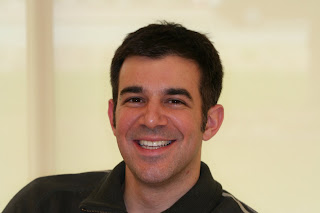
The fillings were important to do first not only to remove the decay before the cavity got worse but also because Jeff would not have been able to have any restorative work done once the Invisalign treatment had started until it was finished. This is because the trays that are used in the treatment are made all at once and progressively shift the teeth into position as the trays are changed out. If restorative dentistry work was done during treatment then the trays would not fit.

For each tooth with a cavity, Dr. Adler removed the decay from the tooth and then placed tooth colored composite resin in the prepared tooth reshaping it to its original shape. A harmless curing light is used to harden and set the material. The tooth is then good as new and the filling is unnoticeable.
Once all the cavities had been restored with composite fillings, Dr. Adler was able to start the Invisalign. An impression of Jeff’s teeth and bite were taken and then sent to Invisalign labs. There a model of Jeff’s mouth was made and scanned as 3-D virtual image. They then made small incremental movements of the virtual teeth to simulate how the aligners would shift the teeth into their final position. Buttons, small tooth colored composite dots placed on selected teeth, were required to help certain teeth shift and rotate more. Once this virtual model was completed, it was sent to Dr. Adler for approval and/or modification. Once approved, the aligners were fabricated for the entire treatment phase and sent back to Dr. Adler. The buttons were places on the selected teeth and Jeff was given his first set of aligners. Each aligner was worn for about two weeks and each new aligner was slightly different to help slowly move the teeth into their proper position. The aligners were clear so it was hard for anyone to know that Jeff had “braces” on. They were removable for easy cleaning and were not worn when eating. Since Jeff had crowded teeth, IPR (inter proximal reduction) was required to give the teeth more room to move. IPR is a very simple and painless procedure that involves Dr. Adler filing a very minuscule portion between the teeth to create a small amount of space that the teeth will later move into. Treatment was completed in 6 month, much less time than traditional braces. The buttons were removed once treatment was done and clear aligner retainers were given to be worn at night to keep the teeth from shifting back.
Jeff had Zoom teeth whitening treatment done to brighten his new smile and remove the discoloration. The Zoom whitening gel was applied to each tooth and then cured with a high intensity curing light that activates the whitening gel. The Zoom light aids in activating the hydrogen peroxide and helps it penetrate the surface of the tooth. This procedure was repeated four times to maximize the whitening effect. After the treatment, Jeff had a noticeably brighter smile. He was given more whitening gel to use with his Invisalign retainers for any need touch up or maintenance bleaching.

Now that Jeff’s teeth were all a beautiful shade of white, the veneers could be placed. A veneer is a thin shell of porcelain that is bonded to a tooth to improve its color or shape. A veneer generally covers only the front and top of a tooth. Veneers can be used to close spaces between teeth, lengthen small or misshapen teeth, or whiten stained or dark teeth.

Jeff’s two upper front teeth on either side of the middle teeth (#7 & 10) were first shaped and roughened to prepare them for the veneers. Impressions were then taken of the teeth and sent to Aurum Ceramic Dental Laboratory, where the veneers were artistically custom crafted. Once the porcelain veneers had returned from the lab, they were cemented onto Jeff’s teeth using a durable adhesive bond. The bond was then cured with a harmless high-intensity light. This final touch completed Jeff’s treatment and he now has exactly what he wanted, a straight and white natural looking smile. The results are stunning and Jeff loves showing off his smile now.
For more information about Boulder cosmetic dentistry procedures please visit our website or call our office at 303-449-11





